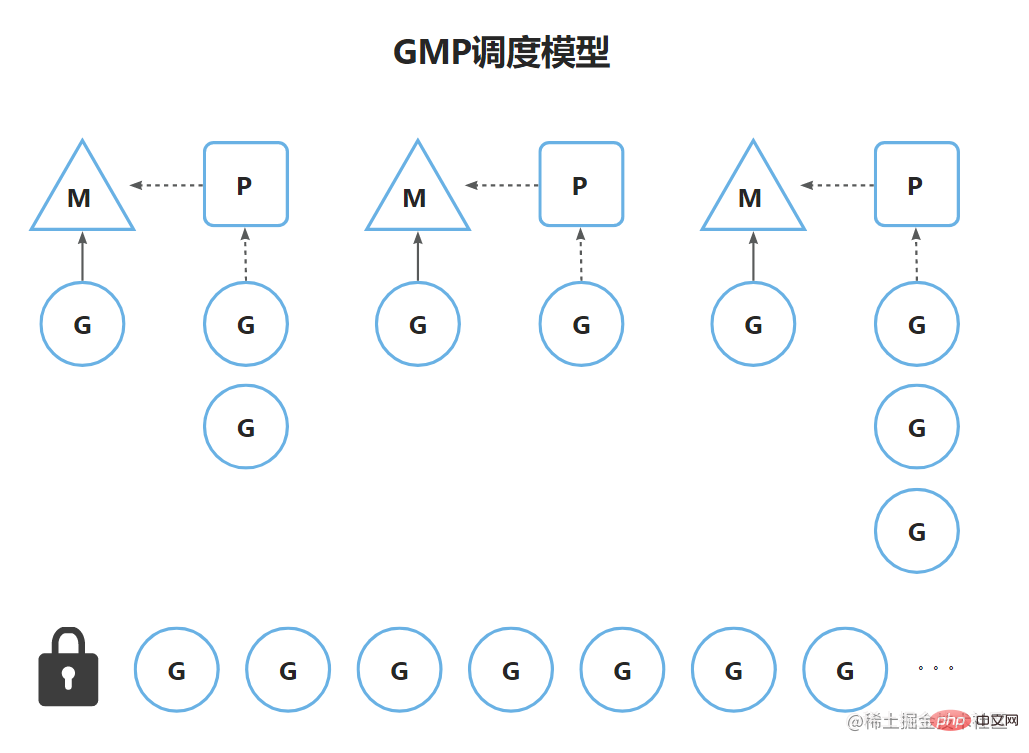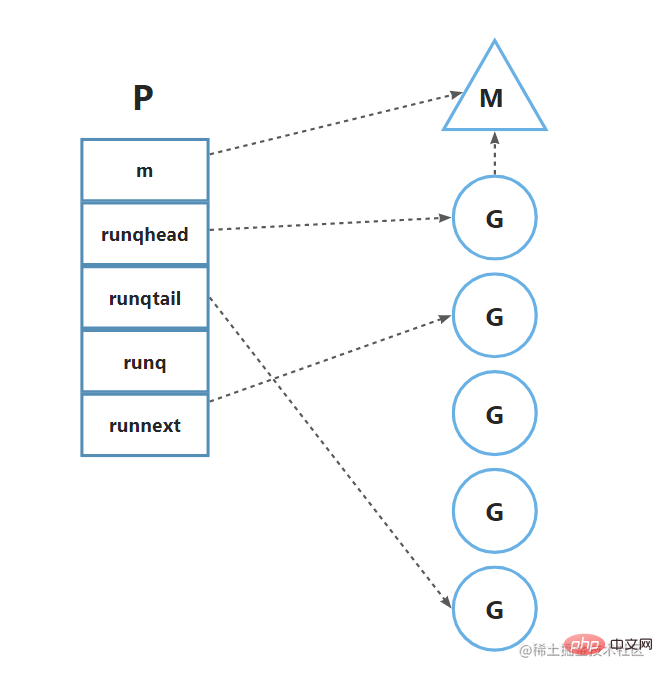 Backend Development
Backend Development
 Golang
Golang
 An in-depth analysis of the reasons why there is a GMP scheduling model in the Go language
An in-depth analysis of the reasons why there is a GMP scheduling model in the Go language
An in-depth analysis of the reasons why there is a GMP scheduling model in the Go language
Why does Go have a GMP scheduling model? The following article will introduce to you the reasons why there is a GMP scheduling model in the Go language. I hope it will be helpful to you!

#The GMP scheduling model is the essence of Go. It reasonably solves the efficiency problem of multi-threaded concurrent scheduling coroutines.
What is GMP
First of all, we must understand what each generation of GMP refers to.
- G: The abbreviation of Goroutine refers to coroutine, which runs on a thread.
- M: The abbreviation of Machine, that is, thead, thread, cyclic scheduling coroutine and execution.
- P: The abbreviation of Processor, refers to the processor, which stores coroutines in local queues and provides available coroutines that are not dormant for threads.
Threads M each hold When a processor P wants to obtain a coroutine, it is first obtained from P, so the GMP model diagram is as follows:

The general process is that thread M obtains it from P's queue If the coroutine cannot obtain it, it will compete for the lock from the global queue to obtain it.
Processor P
The coroutine G and thread M structures have been explained in the previous articles. Here we analyze the processor P.
Function
Processor P stores a batch of coroutines, so that thread M can obtain coroutines from them without locking, without having to compete with other threads for the global queue. Coroutine in the process, thereby improving the efficiency of scheduling coroutines.
Source code analysis
The source code of the p structure is in src\runtime\runtime2.go, and some important fields are shown here.
type p struct {
...
m muintptr // back-link to associated m (nil if idle)
// Queue of runnable goroutines. Accessed without lock.
runqhead uint32
runqtail uint32
runq [256]guintptr
runnext guintptr
...
}mis the thread to which the processorpbelongsrunqis a queue that stores coroutinesrunqhead,runqtailrepresents the head and tail pointers of the queuerunnextpoints to the next runnable coroutine

How do thread M and processor P cooperate?
In src\runtime\proc.go, there is a schedule method, which is the first function run by the thread. In this function, the thread needs to obtain a runnable coroutine. The code is as follows:
func schedule() {
...
// 寻找一个可运行的协程
gp, inheritTime, tryWakeP := findRunnable()
...
}func findRunnable() (gp *g, inheritTime, tryWakeP bool) {
// 从本地队列中获取协程
if gp, inheritTime := runqget(pp); gp != nil {
return gp, inheritTime, false
}
// 本地队列拿不到则从全局队列中获取协程
if sched.runqsize != 0 {
lock(&sched.lock)
gp := globrunqget(pp, 0)
unlock(&sched.lock)
if gp != nil {
return gp, false, false
}
}
}Get the coroutine from the local queue
func runqget(pp *p) (gp *g, inheritTime bool) {
next := pp.runnext // 队列中下一个可运行的协程
if next != 0 && pp.runnext.cas(next, 0) {
return next.ptr(), true
}
...
}If there is no coroutine in the local queue or the global queue What should I do? Should I just let the thread idle like this?
At this time, processor P will steal tasks and steal some tasks from the local queues of other threads. This is called sharing the pressure of other threads and improving the utilization of its own threads.
The source code is in src\runtime\proc.go\stealWork. If you are interested, you can take a look.
Where should the newly created coroutine be allocated?
Should the newly created coroutine be allocated to the local or global queue? Score:
- Go thinks that the new coroutine has a high priority, so it first looks for the local queue to put it in. Enter and jump in line.
- When the queue of this team is full, it will be put into the global queue.
The actual process is:
- Randomly search for P
- Put the new coroutine into P's
runnext, which means The coroutine will be run next and the queue will be jumped. - If P's coroutine is full, it will be put into the global queue
The source code is in src\runtime\proc.go \newproc function.
// Create a new g running fn.
// Put it on the queue of g's waiting to run.
// The compiler turns a go statement into a call to this.
func newproc(fn *funcval) {
gp := getg()
pc := getcallerpc()
systemstack(func() {
newg := newproc1(fn, gp, pc) // 创建新协程
pp := getg().m.p.ptr()
runqput(pp, newg, true) // 寻找本地队列放入
if mainStarted {
wakep()
}
})
}Conclusion
This article initially introduces the GMP scheduling model, and specifically introduces how processor P and thread M obtain coroutines.
Processor P solves the problem of multi-thread mutual exclusion to obtain coroutines and improves the efficiency of scheduling coroutines. However, no matter whether coroutines are in local or global queues, it seems that they are only executed sequentially. So what about Go? How to implement asynchronous and concurrent execution of coroutines? Let’s continue the analysis in the next article (although no one will read it...).
Recommended learning: Golang tutorial
The above is the detailed content of An in-depth analysis of the reasons why there is a GMP scheduling model in the Go language. For more information, please follow other related articles on the PHP Chinese website!

Hot AI Tools

Undresser.AI Undress
AI-powered app for creating realistic nude photos

AI Clothes Remover
Online AI tool for removing clothes from photos.

Undress AI Tool
Undress images for free

Clothoff.io
AI clothes remover

Video Face Swap
Swap faces in any video effortlessly with our completely free AI face swap tool!

Hot Article

Hot Tools

Notepad++7.3.1
Easy-to-use and free code editor

SublimeText3 Chinese version
Chinese version, very easy to use

Zend Studio 13.0.1
Powerful PHP integrated development environment

Dreamweaver CS6
Visual web development tools

SublimeText3 Mac version
God-level code editing software (SublimeText3)

Hot Topics
 How to send Go WebSocket messages?
Jun 03, 2024 pm 04:53 PM
How to send Go WebSocket messages?
Jun 03, 2024 pm 04:53 PM
In Go, WebSocket messages can be sent using the gorilla/websocket package. Specific steps: Establish a WebSocket connection. Send a text message: Call WriteMessage(websocket.TextMessage,[]byte("Message")). Send a binary message: call WriteMessage(websocket.BinaryMessage,[]byte{1,2,3}).
 In-depth understanding of Golang function life cycle and variable scope
Apr 19, 2024 am 11:42 AM
In-depth understanding of Golang function life cycle and variable scope
Apr 19, 2024 am 11:42 AM
In Go, the function life cycle includes definition, loading, linking, initialization, calling and returning; variable scope is divided into function level and block level. Variables within a function are visible internally, while variables within a block are only visible within the block.
 The difference between Golang and Go language
May 31, 2024 pm 08:10 PM
The difference between Golang and Go language
May 31, 2024 pm 08:10 PM
Go and the Go language are different entities with different characteristics. Go (also known as Golang) is known for its concurrency, fast compilation speed, memory management, and cross-platform advantages. Disadvantages of the Go language include a less rich ecosystem than other languages, a stricter syntax, and a lack of dynamic typing.
 How to match timestamps using regular expressions in Go?
Jun 02, 2024 am 09:00 AM
How to match timestamps using regular expressions in Go?
Jun 02, 2024 am 09:00 AM
In Go, you can use regular expressions to match timestamps: compile a regular expression string, such as the one used to match ISO8601 timestamps: ^\d{4}-\d{2}-\d{2}T \d{2}:\d{2}:\d{2}(\.\d+)?(Z|[+-][0-9]{2}:[0-9]{2})$ . Use the regexp.MatchString function to check if a string matches a regular expression.
 How to avoid memory leaks in Golang technical performance optimization?
Jun 04, 2024 pm 12:27 PM
How to avoid memory leaks in Golang technical performance optimization?
Jun 04, 2024 pm 12:27 PM
Memory leaks can cause Go program memory to continuously increase by: closing resources that are no longer in use, such as files, network connections, and database connections. Use weak references to prevent memory leaks and target objects for garbage collection when they are no longer strongly referenced. Using go coroutine, the coroutine stack memory will be automatically released when exiting to avoid memory leaks.
 How to view Golang function documentation in the IDE?
Apr 18, 2024 pm 03:06 PM
How to view Golang function documentation in the IDE?
Apr 18, 2024 pm 03:06 PM
View Go function documentation using the IDE: Hover the cursor over the function name. Press the hotkey (GoLand: Ctrl+Q; VSCode: After installing GoExtensionPack, F1 and select "Go:ShowDocumentation").
 Things to note when Golang functions receive map parameters
Jun 04, 2024 am 10:31 AM
Things to note when Golang functions receive map parameters
Jun 04, 2024 am 10:31 AM
When passing a map to a function in Go, a copy will be created by default, and modifications to the copy will not affect the original map. If you need to modify the original map, you can pass it through a pointer. Empty maps need to be handled with care, because they are technically nil pointers, and passing an empty map to a function that expects a non-empty map will cause an error.
 How to use Golang's error wrapper?
Jun 03, 2024 pm 04:08 PM
How to use Golang's error wrapper?
Jun 03, 2024 pm 04:08 PM
In Golang, error wrappers allow you to create new errors by appending contextual information to the original error. This can be used to unify the types of errors thrown by different libraries or components, simplifying debugging and error handling. The steps are as follows: Use the errors.Wrap function to wrap the original errors into new errors. The new error contains contextual information from the original error. Use fmt.Printf to output wrapped errors, providing more context and actionability. When handling different types of errors, use the errors.Wrap function to unify the error types.





